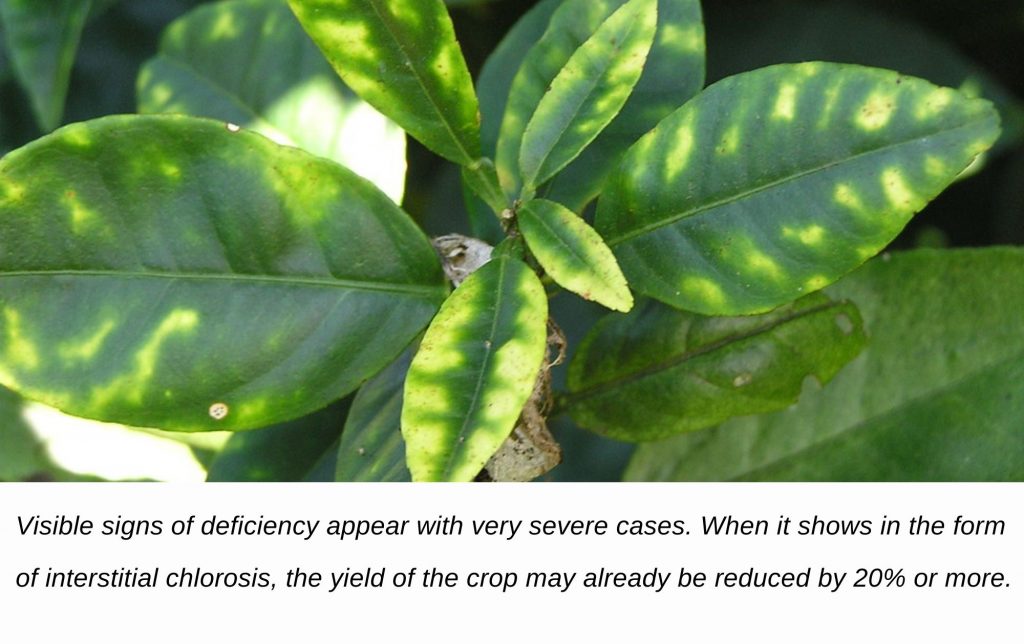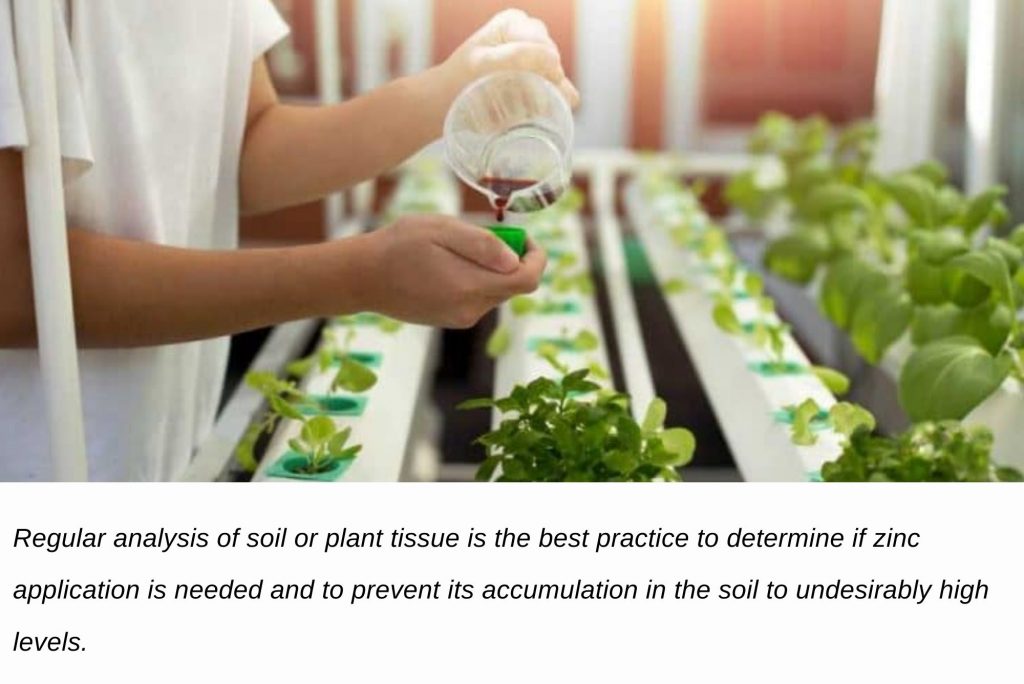Zinc is one of the eight essential micronutrients that plants require for healthy growth. It’s only needed in very small quantities, but it plays a significant role in plant development and growth.
Zinc in nature
This micronutrient is fairly widespread in nature. As a rule, rocks contain zinc in the form of sulfide, and it also replaces magnesium in silicates. The weathering of rocks produces a mobile divalent metal that is readily adsorbed by organic compounds and minerals. In most soils, the microelement accumulates in surface horizons and associates with clay minerals and iron and aluminum hydroxides. Zinc content in soils is determined by the presence of this element in soil-forming rocks and varies from 25 to 100 mg/kg. An increase of its concentration in soil is closely connected with the increase of organic matters in soil, which testifies to the biological accumulation of this element. The fact is that organic matter is capable to bind zinc in stable forms, which leads to its accumulation in organic soil horizon and peat. However, the stability of organic compounds with this element in soils is relatively low.
The zinc cation (Zn2+) is considered the main and most mobile form of the microelement, but some other forms are also present in soils. Factors controlling its mobility in soils are similar to those for copper. The microelement is most mobile and bioavailable in acidic, light, mineral soils. Acid leaching is most effective in mobilizing this metal, so a loss of the microelement is often observed in podzolic and brown acidic soils. Zinc is immobile in soils rich in calcium, phosphorus, sulfur compounds, as well as in soils containing increased amounts of calcium-saturated minerals and water oxides.

Role of Zinc in plants
One of the most significant roles the micronutrient plays in plants is its inclusion in a variety of enzymes: dehydrogenase, peptidase, and phosphohydrolase. There are two main functions zinc normally performs when it comes to plant culture:
- metabolism of carbohydrates, phosphates, and proteins;
- formation of auxins (plant growth hormones), DNA, and ribosomes.
It also affects membrane permeability, stabilizes cellular components and microbial systems, and increases plant resistance to dry and hot climates and fungal and bacterial diseases.
The micronutrient doesn’t take part in the redox processes in plants because of its divalent form.
Zinc deficiency in plants
This micronutrient deficiency is probably the most common in plants worldwide. It’s far from innocuous and has a direct impact on significant yield losses. Zinc deficiency can lead to significant reductions in yields and fruit quality. The losses due to reduced crop productivity are significantly greater than the cost of soil and plant tissue analysis and stocking on fertilizers.
Zinc mobility in plants varies depending on its availability in soil or hydroponic substrates. When its availability is normal, it’s easily transferred from older to younger leaves. In the case of zinc deficiency, the transfer of the micronutrient from older to younger leaves is delayed.
This means that it initially appears on middle-aged leaves.
The signs of zinc deficiency in plants
The symptoms of shortage include one or more of the following features:
- stunted growth, dwarfing;
- short internodes;
- interstitial chlorosis;
- brown spots on the upper leaves;
- misshapen leaves and fruits.
Visible signs of deficiency appear with very severe cases. When it shows in the form of interstitial chlorosis, the yield of the crop may already be reduced by 20% or more.

This type of micronutrient shortage is common in many crops and soil types. It most often affects major cereal crops such as rice, wheat, and corn, but also various fruit crops and other plant species.
Soil factors associated with zinc deficiency
- General low content of the micronutrient (available or unavailable);
- Low organic matter content or the opposite: too much organic matter in the soil (i.e. peaty soils);
- Weak microbial activity in the soil;
- Limited root growth (due to hard subsoil or high water table);
- High pH;
- Calcareous soils;
- Low soil temperature;
- Anaerobic conditions, waterlogged soils;
- High phosphorus levels in the soil.
Among crops, buckwheat, potatoes, and beets are highly sensitive to zinc shortage. Some crops, in particular peas and tomatoes, increase phosphorus uptake. At the same time, its inorganic form content increases, and that of nucleotides, lipids, and nucleic acids decreases. In general, zinc requirements in fruit crops, and especially in citrus fruits, are higher than in field crops. Apple trees suffer from the lack of the micronutrient more often than other fruit crops. The apical leaves of the plants turn lighter, become elongated, and show necrosis along the edges.
Fixing zinc deficiency
In case the lack of the micronutrient is detected, zinc-rich fertilizers can be applied. The most common sources are zinc chelates (containing about 14% of the micronutrient), zinc oxide (70-80%), and zinc sulfate (25-36%). The latter is the most commonly used source of the micronutrient.
Applying fertilizer to the leaf is not as effective as applying it to the soil. It’s worth mentioning that if the soil has a high phosphorus content, the application of zinc may not have the desired effect. In that case, foliar applications will be more effective. Leaf feedings help to eliminate visual symptoms faster, but they are less effective at increasing yields.
Excess of zinc in plants
An excess of the micronutrient in the soil is rather rare but does happen. Most plants are well adapted to the micronutrient’s excessive concentrations. The usual signs of excess are:
- chlorosis (especially on young leaves);
- stunted plant growth.
Detecting zinc level abnormalities
Continuous visual inspection can be a good way of detecting the deficiency or excess of the micronutrient. However, it requires knowledge and experience because some symptoms can be misleading. In addition, it’s important to understand that once visual symptoms appear, the damage to the crop has already been done.
Regular analysis of soil or plant tissue is the best practice to determine if zinc application is needed and to prevent its accumulation in the soil to undesirably high levels. DTPA (diethylenetriaminepentaacetic acid) extraction is the most commonly used method of soil analysis to determine available zinc levels.
Zinc toxicity
This is rather rare but it might happen when the content of the micronutrient in the tissue exceeds 200 ppm. Symptoms show as smaller leaf size, chlorosis of younger leaves, necrotic tips, stunted growth, or reduced root development.
If you believe your plants may suffer from zinc deficiency it’s important to check their pH level since lower than optimal levels increase the risk of toxicity symptoms developing including crinkled leaves and wilting/discoloration on stems near nodes (where vascular tissue meets internodes). Before testing, be sure to clean the leaves. Some fungicides include zinc, which impacts the tissue test results.
Conclusion
There are many symptoms of zinc deficiency, but if you spot the problem in its early stages, it’s easy to deal with. If you make sure that the amount of this important micronutrient in your soil is just enough, you can rest assured the issue won’t bother you for years to come.


